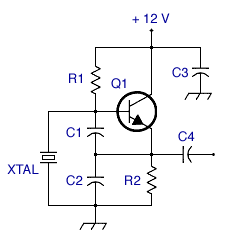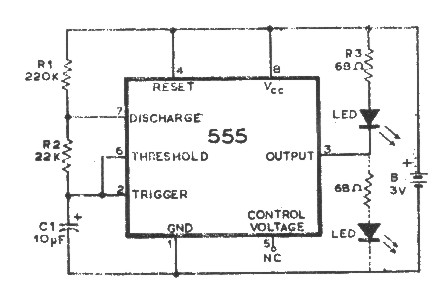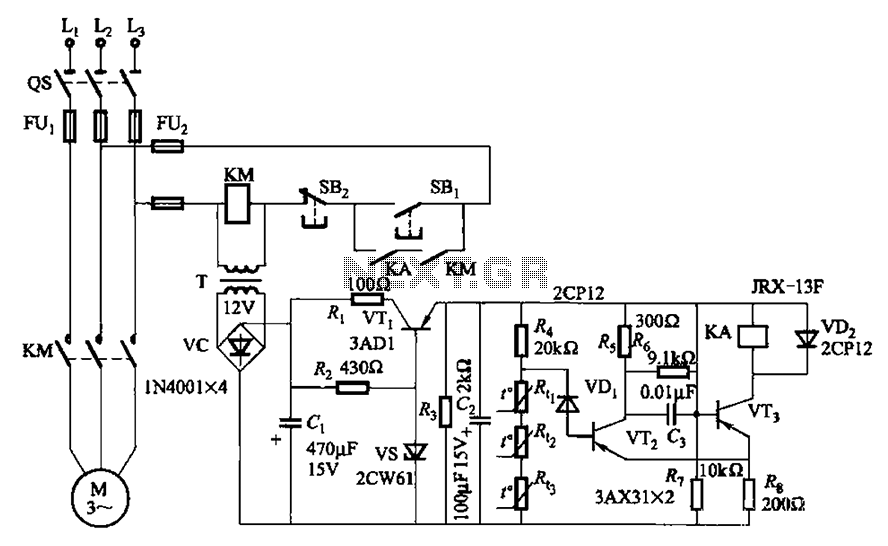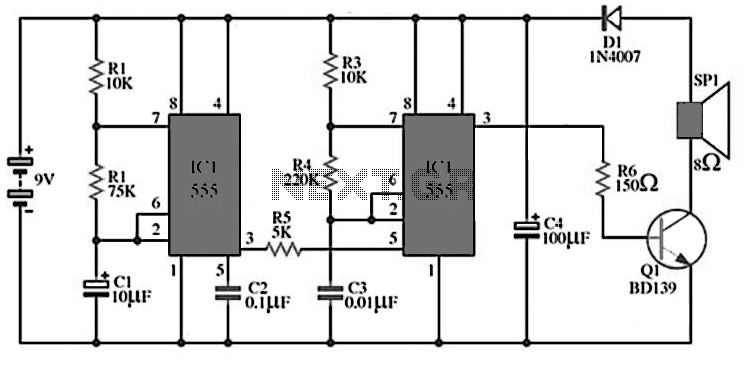
Game Circuits
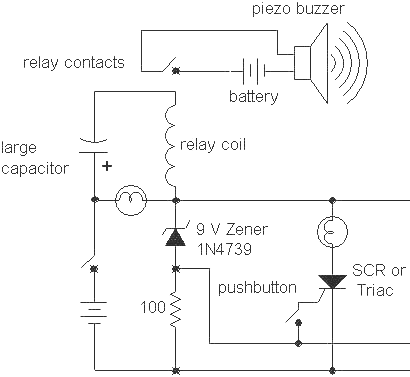
This is a simple game show timer designed for beginners. The power source can be a standard 12-volt lantern battery or a battery pack made from C or D cells. The lamps used can be regular flashlight bulbs; the prototype employs 750 mA Krypton bulbs (KPR112) with wires soldered directly to them. The control devices can be any non-sensitive gate SCRs or triacs with a current rating of a few amps. It is advisable to avoid SCRs that require a trigger current in the range of hundreds of microamperes; a gate trigger current of a few milliamperes is recommended to prevent multiple lights from activating simultaneously. A low-value resistor, such as 470 ohms, may be added from the gate to -12 volts to minimize false triggering. SCRs are depicted in the schematic, while triacs can be substituted by connecting MT1 to the negative battery terminal and MT2 to the lamps. Mixing the two types of devices is permissible as long as sensitive gate types are not used. The zener diode should be a standard 9-volt, 1-watt type like the 1N4739. The 100-ohm resistor can be any type rated at 1/8 watt or higher. The reset/power button is a standard toggle switch, and the pushbuttons can be any convenient normally-open type. The entire circuit can be housed in one enclosure with two wires running to each contestant's pushbutton switch, or the SCR, lamp, and switch can be placed in a remote box for each contestant with three wires returning to the base unit. Additional contestants can be added by repeating the pattern. The schematic shows three lower lamps soldered directly to the MT2 terminals of triacs (or anodes if SCRs are utilized). The selected triacs (RCA T2710) come with an integral heat sink connected to MT2. The gate leads connect to the pushbuttons (identified by red wires), and the other ends of the pushbuttons connect to the resistor-zener junction (identified by white wires). The 100-ohm resistor is the small brown component, while the zener diode is the silver component. The brown wires connect the MT1 terminals (cathodes) to the negative battery wire. The positive battery wire connects to the base unit lamp, which is directly linked to the other three bulbs (bulb polarity is not a concern). The schematic includes a 2200uF capacitor in series with a 5 or 6-volt reed relay coil; a larger capacitor will produce a longer buzz. A 9-volt battery is connected in series with the relay's normally-open contacts and a piezo buzzer. A separate battery is recommended to prevent electrical noise from the buzzer from triggering the other SCRs. Other battery and buzzer voltages/types may also be used. A more complex version utilizing easily sourced bipolar transistors is available, requiring only two wires between stations and the base unit, which can be connected anywhere on the bus. Stations can be wired back to the base unit or daisy-chained from one to the next with a single set of wires returning to the base unit. The game show timer determines which contestant presses their button first by illuminating a lamp and sounding a bell, while slower contestants are locked out. The circuit is designed for convenience, needing only two wires to interconnect the stations, which can either return to the base unit or be daisy-chained. There is no electronic limit on the number of stations. The circuit operates with a 24-volt power source and 12-volt lamps as shown, although experienced experimenters may adjust these voltages along with the zener voltages as needed.
The game show timer circuit is structured to facilitate an interactive experience among multiple contestants. It employs a straightforward design that allows for easy assembly and modification. The circuit's core consists of a power supply, control devices, and output indicators (lamps). The use of SCRs or triacs as control devices is crucial, as they enable the switching of high current loads (the lamps) while being triggered by low current signals from the pushbuttons.
The inclusion of a 470-ohm resistor from the gate to the negative terminal is a critical design element that enhances reliability by reducing the likelihood of false triggering, which could occur due to noise or interference. The choice of a 9-volt zener diode ensures that the control voltage remains stable, allowing for consistent operation of the SCRs or triacs.
The circuit's modularity is one of its standout features. Each contestant station can be independently constructed and then connected back to a central base unit, allowing for scalability without a significant increase in complexity. This modular approach is particularly beneficial in environments where multiple contestants may participate simultaneously, such as in a game show setting.
The use of a piezo buzzer in conjunction with a relay adds an auditory feedback mechanism, further engaging contestants and providing immediate feedback on their actions. The design allows for flexibility in component selection, accommodating various types of components that may be available, which is advantageous for hobbyists and educators alike.
In summary, this game show timer circuit is an excellent project for beginners, combining fundamental electronic principles with practical application in a fun and interactive format. Its design promotes learning and experimentation, making it a valuable educational tool.Here is a really simple game show timer designed with the beginner in mind! The power source is an ordinary 12 volt lantern battery or battery pack made up of C or D cells. The lamps may be ordinary flashlight bulbs; the prototype uses 750 mA Krypton types (KPR112) with wires soldered directly onto the bulbs. The control devices may be just about any non-sensitive gate SCRs or triacs with a current rating of a few amps. Avoid SCRs that trigger with 100s of microamperes; you want a gate trigger current of a few mA or else you will have trouble with more than one light coming on at once. A low value resistor, perhaps 470 ohms may be added from gate to -12 volts to reduce false triggering.
SCRs are shown and triacs may be substituted by connecting MT1 to the negative battery terminal and MT2 to the lamps. In fact, the two types of devices could probably be mixed if that is what the junk box has to offer! (But not sensitive gate types!) The zener is an ordinary 9 volt, 1 watt type like the 1N4739. The 100 ohm resistor may be any type with a rating of 1/8 watt or more. The reset/power button is an ordinary toggle switch and the pushbuttons are any convenient normally-open type.
The entire circuit may be built into one box with two wires running out to each contestant`s pushbutton switch or the SCR, lamp, and switch may be in a remote box for each contestant with three wires running back to the base unit. Many more than three contestants may be added by repeating the pattern. Here is what you see: The three lower lamps are soldered directly to the MT2 terminals of triacs (anodes if SCRs are used).
These particular triacs (RCA T2710) come with an integral heat sink connected to MT2. The gate leads (on the left) connect to the pushbuttons (red wires) and the other end of the pushbuttons all go to the resistor-zener junction (white wires). The 100 ohm resistor is the tiny brown part and the zener is the silver part. The brown wires connect the MT1 terminals (cathodes) to the negative battery wire. The red positive battery wire connects to the base unit lamp which is directly connected to the other three bulbs.
(Bulb "polarity" is not important. ) The schematic shows the 2200uF capacitor in series with a 5 or 6 volt reed relay`s coil; the larger the capacitor, the longer the buzz. A 9 volt battery is connected in series with the relay`s normally-open contacts and a piezo buzzer. The separate battery is highly recommended to prevent electrical noise from the buzzer from triggering the other SCRs.
Other battery and buzzer voltages/types will also work. Here is a somewhat more complex version that uses easily found bipolar transistors. Note that it requires only two wires between stations and base and those wires can be connected anywhere on the "buss". (You can wire each station back to the base unit or "daisy chain" the stations from one to the next with only one set of wires going back to the base unit.
) The game show timer determines which contestant presses their button first by lighting a lamp and ringing a bell and the slower contestants are locked out. The circuit is convenient in that only two wires are needed to interconnect the stations and the wires may all go back to the base unit or they may be "daisy-chained" between stations.
There is no electronic limit on the number of stations. The circuit uses a 24 volt power source and 12 volt lamps when built as shown but the experienced experimenter may scale these voltages along with the zener voltages if desired. 🔗 External reference
The game show timer circuit is structured to facilitate an interactive experience among multiple contestants. It employs a straightforward design that allows for easy assembly and modification. The circuit's core consists of a power supply, control devices, and output indicators (lamps). The use of SCRs or triacs as control devices is crucial, as they enable the switching of high current loads (the lamps) while being triggered by low current signals from the pushbuttons.
The inclusion of a 470-ohm resistor from the gate to the negative terminal is a critical design element that enhances reliability by reducing the likelihood of false triggering, which could occur due to noise or interference. The choice of a 9-volt zener diode ensures that the control voltage remains stable, allowing for consistent operation of the SCRs or triacs.
The circuit's modularity is one of its standout features. Each contestant station can be independently constructed and then connected back to a central base unit, allowing for scalability without a significant increase in complexity. This modular approach is particularly beneficial in environments where multiple contestants may participate simultaneously, such as in a game show setting.
The use of a piezo buzzer in conjunction with a relay adds an auditory feedback mechanism, further engaging contestants and providing immediate feedback on their actions. The design allows for flexibility in component selection, accommodating various types of components that may be available, which is advantageous for hobbyists and educators alike.
In summary, this game show timer circuit is an excellent project for beginners, combining fundamental electronic principles with practical application in a fun and interactive format. Its design promotes learning and experimentation, making it a valuable educational tool.Here is a really simple game show timer designed with the beginner in mind! The power source is an ordinary 12 volt lantern battery or battery pack made up of C or D cells. The lamps may be ordinary flashlight bulbs; the prototype uses 750 mA Krypton types (KPR112) with wires soldered directly onto the bulbs. The control devices may be just about any non-sensitive gate SCRs or triacs with a current rating of a few amps. Avoid SCRs that trigger with 100s of microamperes; you want a gate trigger current of a few mA or else you will have trouble with more than one light coming on at once. A low value resistor, perhaps 470 ohms may be added from gate to -12 volts to reduce false triggering.
SCRs are shown and triacs may be substituted by connecting MT1 to the negative battery terminal and MT2 to the lamps. In fact, the two types of devices could probably be mixed if that is what the junk box has to offer! (But not sensitive gate types!) The zener is an ordinary 9 volt, 1 watt type like the 1N4739. The 100 ohm resistor may be any type with a rating of 1/8 watt or more. The reset/power button is an ordinary toggle switch and the pushbuttons are any convenient normally-open type.
The entire circuit may be built into one box with two wires running out to each contestant`s pushbutton switch or the SCR, lamp, and switch may be in a remote box for each contestant with three wires running back to the base unit. Many more than three contestants may be added by repeating the pattern. Here is what you see: The three lower lamps are soldered directly to the MT2 terminals of triacs (anodes if SCRs are used).
These particular triacs (RCA T2710) come with an integral heat sink connected to MT2. The gate leads (on the left) connect to the pushbuttons (red wires) and the other end of the pushbuttons all go to the resistor-zener junction (white wires). The 100 ohm resistor is the tiny brown part and the zener is the silver part. The brown wires connect the MT1 terminals (cathodes) to the negative battery wire. The red positive battery wire connects to the base unit lamp which is directly connected to the other three bulbs.
(Bulb "polarity" is not important. ) The schematic shows the 2200uF capacitor in series with a 5 or 6 volt reed relay`s coil; the larger the capacitor, the longer the buzz. A 9 volt battery is connected in series with the relay`s normally-open contacts and a piezo buzzer. The separate battery is highly recommended to prevent electrical noise from the buzzer from triggering the other SCRs.
Other battery and buzzer voltages/types will also work. Here is a somewhat more complex version that uses easily found bipolar transistors. Note that it requires only two wires between stations and base and those wires can be connected anywhere on the "buss". (You can wire each station back to the base unit or "daisy chain" the stations from one to the next with only one set of wires going back to the base unit.
) The game show timer determines which contestant presses their button first by lighting a lamp and ringing a bell and the slower contestants are locked out. The circuit is convenient in that only two wires are needed to interconnect the stations and the wires may all go back to the base unit or they may be "daisy-chained" between stations.
There is no electronic limit on the number of stations. The circuit uses a 24 volt power source and 12 volt lamps when built as shown but the experienced experimenter may scale these voltages along with the zener voltages if desired. 🔗 External reference
Warning: include(partials/cookie-banner.php): Failed to open stream: Permission denied in /var/www/html/nextgr/view-circuit.php on line 713
Warning: include(): Failed opening 'partials/cookie-banner.php' for inclusion (include_path='.:/usr/share/php') in /var/www/html/nextgr/view-circuit.php on line 713
